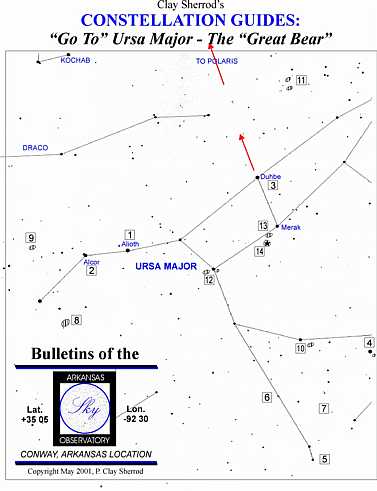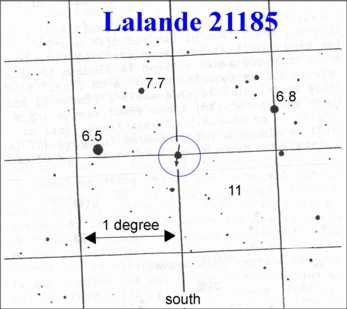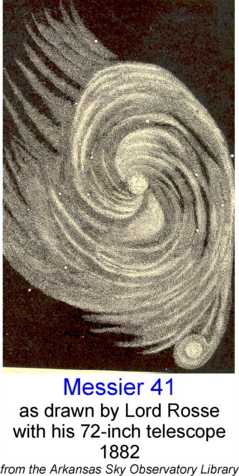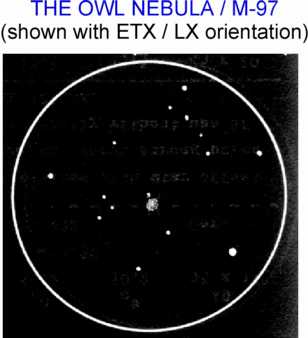CONSTELLATION GUIDE
Last updated: 22 April 2001
CONSTELLATION GUIDE |
"GO TO"....URSA MAJOR
Touring the "Greater Bear" With Your ETX and LX 90 Telescope
From: sherrodc@ipa.net (Clay Sherrod)
ABOUT THE CONSTELLATION "GO-TO" GUIDES!
As a result of a wonderful recommendation urging me to write a "guided tour" through various constellations via the GO TO function of our telescopes (as well as many references to those who wish - or MUST in the case of the ETX 90RA -to locate manually), this is the first in a series of OBSERVATION GUIDES entitled:
"GO TO [ -constellation name- ]"
Touring the Constellations With Your ETX and LX 90 Telescope
This first installment, "GO TO URSA MAJOR", features "the Big Dipper" since it so prominent throughout all seasons of each; it features a "start" with an easy GO TO to the bright star ALIOTH, and then get rights into the guts of it, with a slew to the beautifully-colored and complex multiple star system ALCOR AND MIZAR, with discussions along the way and what to expect from each telescope size and type. We will view the multiple star systems, galaxies, and all deep sky phenomenon with exact descriptions of what the viewers of the ETX 60/70, ETX 90, ETX 125, and LX 90 should expect to see...and what to NOT expect to see!
The finest stellar and deep sky objects in the constellation will be featured....and - yes - there will be something for everyone and every telescope...Even naked eye and binoculars when appropriate!
Discussed are useful magnifications for EACH GO TO object, what type of night and conditions are needed to see certain details, double stars that can be resolved in each telescope model, and much, much more. It is your complete GUIDE for your deep sky observing pleasure and a very handy tool for use at your next star party!
Needless to say, it WILL put your AutoStar to work for you in a most efficient and enjoyable way!
I hope you will enjoy these comprehensive GUIDES to "Touring the Constellations" which will feature a NEW constellation about every two weeks, complete with diagrams, charts and illustrations. Please let us hear from you with summations of YOUR observations through these constellation tours!
----------------------------------
"GO TO"....URSA MAJOR
Introduction -
The wonderfully recognizable constellation URSA MAJOR is known by many names: throughout history the seven bright stars have been referred to as "seven wise men", King Arthur's chariot, the English Plough of oxen, and even the Egyptian boat of the God Osiris. In modern cultures these stars are commonly referred to as "the Big Dipper," appearing as a large ladle in the sky.
Indeed, the seven bright stars and many others nearby are part of an actual star ASSOCIATION, stars held together and moving relatively together in space; the Ursa Major association is only 75 light years distant from us here on Earth, and the group measures about 30 by 15 light years across and contains perhaps a total of 17 stars.
The images of the bright "dipper stars" of Ursa Major are a favorite with artists, among them Van Gogh who portrayed them often, and most notably on his work "Starry Night on the Rhone."
The "Great Bear" designation for this constellation and star association is deeply rooted in both history and culture. Worldwide it has bee associated with the furry beast, from Aristotle, to the American Iroquois and Algonquin, while oddly the ancient Chinese saw virtually every imaginable connection to this star pattern - from scales, mountain peaks, to floating sky-lofted temples - EXCEPT a bear.
---------------------------------
YOUR URSA MAJOR "GO TO" TOUR - THE CONCISE DIRECTORY
We will concentrate on 14 objects in Ursa Major for this quick tour; all are in reach of every telescope in our "ETX and LX family" yet each telescope will demonstrate uniquely different and challenging aspects of the objects. While we cover the 14 finest objects, there are MANY more exciting things to see in Ursa Major than those given here - hundreds of double and multiple stars, hundreds of galaxies and deep sky objects, stars of curious colors and motion - that can be found with your telescope.
I recommend good a good star atlas and/or chart which lists the finest objects constellation-by-constellation; you merely need to hold down your MODE key on the AutoStar for three (3) seconds and the RA and DEC coordinates appear for the telescope. Merely press "GO TO" and the cursor appears prompting you to enter the Right Ascension of the object if it is NOT listed among the objects in the AutoStar library; once the RA is entered, press "Enter" and the cursor once again prompts for the Declination coordinates (these coordinates for epoch 2000) are found in all good observing guides). Once those are entered, merely press "GO TO" once again and your ETX or LX 90 will slew to the position of the object!
Now, just use this constellation guide to point out the details of each object you wish to view.

The special star chart here will get you started, as it demonstrates the relative positions of all objects in this "tour" to the seven conspicuous stars of "the big dipper." NOTE that Messier 51 (object #8 on this list)is actually in Canes Venatici, not Ursa Major, but is included here because it is a favorite for this portion of the sky (most people think it is in Ursa Major anyway....so that gives me the right to include it here....and there will likely NOT be a constellation GUIDE for Canes Venatici anyway).
Following is the complete 14-object list for your "GO TO TOUR" of Ursa Major; you may wish to find the majority of the objects from the AutoStar library (for example, you can merely pull up Messier 81 by going to "Object/Deep Sky/Messier Object/M-81....enter....GO TO" or...if you want to experiment and be a "better AutoStar user", try entering the following coordinates as described under MODE above.
OBJECT 1:
star - ALIOTH - R.A. 12h 52' / DEC + 56 14 - Magnitude: 1.8
OBJECT 2:
multiple star - ALCOR & MIZAR - R.A. 13h 22' / DEC + 55 11 (Mizar) - Magnitudes: 4.0 & 2.4, respect.
OBJECT 3:
multiple star - DUHBE - R.A. 11h 01' / DEC + 62 01 - Magnitude: 1.8
OBJECT 4:
multiple star + galaxy - TANIA AUSTRALIS (MU UMa) + ngc3184 - R.A. 10h 19' / DEC + 41 45
Magnitude: 3.1 (galaxy is 10.3m)
OBJECT 5:
multiple star - ALULA AUSTRALIS (XI UMa) - R.A. 11h 16' / + 31 49 - Magnitudes: 4.3 & 4.8
OBJECT 6:
multiple star - 57 Ursa Majoris - R.A. 11h 26' / DEC + 39 37 - Magnitudes: 5.3 & 8.5
OBJECT 7:
one of the closest stars - LALANDE 21185 - R.A. 11h 01' / DEC + 36 18 - Magnitude: 7.6
OBJECT 8:
face-on galaxy - Messier 51("Whirlpool Galaxy - ngc 5194) - R.A. 13h 28' / DEC + 47 27 - Magnitude: 8.1
OBJECT 9:
difficult galaxy - Messier 101 (ngc 5457) - R.A. 14h 01' / DEC + 54 35 - Magnitude: 9.5
OBJECT 10:
bright symmetrical galaxy - ngc 2841 - R.A. 09h 19' / DEC + 51 12 - Magnitude: 9.3
OBJECTS 11:
beautiful galaxies: Messiers 81 & 82 (ngc3031 & 3034) R.A. 09h 52' / DEC + 69 18
Magnitudes: 7.9 & 8.8 (81 is spiral, 82 is irregular)
OBJECT 12:
very difficult galaxy - Messier 109 (ngc 3992) - R.A. 11h 55' / DEC + 53 39 - Magnitude: 10.7
OBJECT 13:
very difficult galaxy - Messier 108 (ngc 3556) - R.A. 11h 09' / DEC + 55 57 - Magnitude: 10.7
OBJECT 14:
nice planetary nebula - Messier 97 (the "Owl nebula") - R.A. 11h 12' / DEC + 55 18 - Magnitude: 11.2
--------------------------------------------
A VISUAL GUIDE TO THESE OBJECTS -
Object 1 - Bright Star Alioth
We begin our journey through Ursa Major with a slewed GO TO to the bright star ALIOTH. Obviously, "epsilon Ursa Majoris" as it is also known is bright enough to locate with the naked eye, marking the "inside-most bright star of the "dipper's handle." Actually, at magnitude 1.79, Alioth is the brightest star of Ursa Majoris....NOT Duhbe, which has the distinction of its ALPHA designation. Alioth derives its name from the Arabic and can be translated curiously as either "bright eye," or strangely...."fat tail." It is an "A" spectral type star, very similar to our own sun although some 80 times more luminous.
Object 2 - Multiple Stars Alcor and Mizar (Zeta Ursa Majoris)
This has the distinction of being the first double star ever recorded.....in more ways than one. Mizar is a double in itself, which was discovered in 1650....prior to that legend has it that the pair with Alcor had them as the "horse and rider" to native North American people. The star purportedly was used as an eyesight test for young warriors...those who could make out the "rider" (Alcor) atop his "horse" (Mizar) was deemed suitable for the trials of manhood. Alcor and Mizar present my absolute FAVORITE color contrasts of the sky, surpassing even the famed "Albireo" in Cygnus. Mizar is a distinctive yellow-white color, contrasting beautifully with Alcor, which shows itself as a green or blue star, depending on who is looking. Alcor, at magnitude 4.0, is the fainter of the two and is immediately east of Mizar; the pair is easy at the lowest power in the ETX 60 and up. Medium power in the ETX 90 and up will reveal "MIZAR B", a bit fainter than Mizar and appearing much closer than Alcor to the primary star; all three can be seen in the same field of view with the ETX 125 and LX 90, with clear separation of Mizar, but with still enough field to accommodate Alcor with a wide angle eyepiece. The faint galaxy Messier 101 (# 9 on our list) is immediately EAST of Mizar.
Object 3 - Bright Star & Multiple Star Duhbe (Alpha Ursa Majoris)
A relatively easy star to see, a companion star encircles the bright star Duhbe at about 6 minutes arc. This 7th magnitude star reveals itself in all the telescopes, but ONLY with fairly high magnification to overcome the glare of the 2nd magnitude Duhbe. the name "Duhbe" is also Arabic, signifying the "back of the great bear." Although Duhbe is itself a double, only very large telescopes can reveal this difficult double star. Although Duhbe system is only 3 times more massive than our sun, the system puts out an incredible luminosity almost 150 times brighter than the sun.
Object 4 - Double Star Tania Australis (Mu Ursa Majoris) and Nearby Galaxy ngc 3184
This is an incredible object for all telescopes and a good target for the ETX 60, 70 and 90. Always observe this nice double with low magnification for an outstanding and curious difference in color! The main component of Mu is a very, very red RED GIANT star of the M-class, contrasting nicely to the more mainstream and yellow component. Mu itself is magnitude 3.1. Due WEST of this interesting star, don't miss the opportunity (in the same field of view of your 26mm eyepiece!) to see the small spiral galaxy, ngc3184. In very large scopes and photographically, this is one of the most beautiful face-on spirals there is, with delicate rotating spiral arms from a highly concentrated central nucleus. In the ETX 125 and LX 90 it appears as a uniform round (very small) glow with a concentrated brightness in the center; the smaller scopes will show this galaxy a medium-high power, but typically will NOT reveal the nucleus.
Object 5 - Nice, but difficult Double Star Alula Australis (XI Ursa Majoris)
The beautiful name denoting "First Spring" is rivaled only by the beauty of this very close and equal magnitude double star. Both stars are about 4.5 magnitude and extremely difficult, except in the LX 90. Under steady skies and when overhead (high power) the ETX 90 will show some elongation to the pair, and the ETX 125 might see a bit of a thread of darkness between these two stars. Both stars are very similar to our own sun. In about 15 years, these stars will appear farther apart from Earth (over 3" arc) and thus be easily resolved in all telescopes under high power.
Object 6 - Double Star 57 Ursa Majoris
This is an outstanding double star, and typically resolvable in even the smaller telescopes under very high power on a good night. They are solar-type stars at magnitude 5 and magnitude 8 and are separated by about 5.5 seconds arc. Because of the relative faintness of the companion star, this is truly a TEST for the ETX 60 and 70, but it can be seen on very good nights.
Object 7 - Lalande 21185 - One of the Closest Stars Outside Our Solar System
This is a star that - in your lifetime - you can actually chart as it moves! It is so close to Earth, at only 8.3 light years (!) that it shows great "proper motion" as it moves against more distant stars behind it. It moves almost 5" arc annually due southward (due north of this interesting object is the nice double star "51 Ursa Majoris, so be sure and check that out while in the neighborhood). Lalande 21185 is the fourth-closest of all stars outside of our sun. At magnitude 7.6, this might be a hard star to spot....but use the following chart to help you (magnitudes of some nearby stars are given). ALSO, you can find this star easily by remembering that it is CRIMSON RED, being a nice example of a true RED DWARF star. The grid marks on the following chart are 1 degree; the ETX 125 and ETX 90 provide just under and over (respectively) a one-degree field with the 40mm Super Plossl eyepiece for reference; the LX 90 will require the 32mm Super Wide to achieve the same field, whereas the LX 60 and 70 give so much field that you might be confused by all you see!

Object 8 - The Whirlpool Galaxy (actually in Canes Venatici)
Although this is a favorite, both visually and photographically, this is a pretty tough object UNLESS you are observing on a very dark night away totally from city lights. In suburban conditions, even the ETX 125 or the LX 90 will show little detail, other than the bright central core of this face-on galaxy and the other smaller "companion" galaxy that appears to be attached to one arm of this famous sight. In very dark conditions, even the ETX 60 and 70 will clearly show both of these components at medium power and as well will show the one large spiral arm leading down to the "companion." Some detail other that this one arm and a clear dark "lane" between it and the galaxy center will be revealed to the ETX 125 and the LX 90 at about 120x under very, very dark conditions. HOWEVER...do not expect to see what Lord Rosse "saw" (uh-huh.....) in his massive 72 inch reflecting telescope over 130 years ago, as shown in the rare drawing shown below.

Clearly Mr. Rosse had much greater "mental resolving power" than perhaps he did "visual acuity" resolving power. Nonetheless, it is interesting to look at his clearly-recorded spiral nature of this object decades before the true nature of spiral galaxies and their structures were even eluded to!
Object 9 - Galaxy: Messier 101
Due east of Mizar, this is a very difficult galaxy, even for the LX 90 under normal suburban conditions; it is shown clearly under dark sky conditions in both the ETX 125 and the LX 90 however. It is not an object that should worry users of the ETX 60, 70, or 90 however, although it can be glimpsed as a "smudge" in the latter telescope on very dark nights. It is a relatively large (7' arc) face-on galaxy which exhibits no features at all in any of these telescopes; however, large scopes with long-exposure photographs reveal a beautiful spiral structure exhibiting many huge star clouds within this galaxies spindle-like arms. On the very DARKEST nights, the LX 90 may reveal globules of stars that are, in fact, images of these huge star swarms. Lord Rosse (see M-51 above) was the first to note the spiral structure of this object in his giant 72-inch reflector.
Object 10 - NGC 2841, a Nice Elongated Galaxy
This may be the finest example of a tightly-wound spiral type Sb galaxy; in the ETX 90 and larger scopes you can clearly see its elongated elliptical shape. This spiral has many, many distinct arms that can only be made out with the largest telescopes. This "whorls" can be glimpsed on very steady and dark nights with the LX 90, but not easily. It is a large (6' x 2' arc) elliptical shape, very bright across its entire length. Even at magnitude 10.2, this galaxy CAN be glimpsed at medium power with the ETX 60 and 70 scopes.
Objects 11 - Famous Messiers 81 and 82
Messier 81 is a bright, compact spiral galaxy; its two outer, very delicate, arms may be glimpsed in fleeting moments with the 8" scope under extremely dark skies; the ETX 125 fails to show these. Medium power (about 20x per inch) shows the best views in all scopes. This is the larger and brighter of the M81-M83 pair which can be framed nicely in the SAME FIELD of the ETX 60 and 70 even under medium power. On a dark night, this provides a spectacular sight. Look for a white, very uniform brightness for M-81 and elongated in a NE-SE direction only very slightly. A brighter center 1/2 of this object can be seen clearly in the ETX 90 in dark skies. Immediately about 1/2 degree NORTH of M-81 is the slightly less bright Messier 82, a very chaotic, eruptive and much more interesting sight than M-81. Even with the ETX 90 and a power of about 160x, much "mottling" of this cigar-shaped patch of light can be witnessed; in the ETX 125 and LX 90 on a very dark night, the sight of this cataclysmic system is sometimes overwhelming. I recently had my best view of this from the Mountain with the LX 90 and a magnification of about 230x. Seven distinct bright "globular" masses could be discerned and much dark matter in between; at that magnification, M-82 almost filled 1/2 of the field of view. Although dimmer and a bit smaller than its M-81 companion, I have always found M-82 to be a much more rewarding object telescopically. The ETX 60 and 70 will clearly show the cigar-shape of this galaxy under high power, although no discernable detail should be expected.
Object 12 - Messier 109 and Galaxy ngc3953
Messier 109, just east off the bright star Phecda in the "bowl" of the dipper, is the toughest of all objects on this list....forget sighting it with the ETX 60 and 70 and expect much difficulty and a disappointing view (if you DO see it) in the ETX 90 and ETX 125; the LX 90 really does not do much for it either. I have put it here only because it is one of the many Messier objects, although this is controversial to Messier's original list of 100. This, curiously, is one of the largest galaxies on this list at a size of 6.5' x 3.5' arc, but it is very faint at nearly magnitude 11. It is a tightly-wound type Sb spiral, but only reveals its nature in long-exposure photographs through very large telescopes.
Object 13 - Galaxy Messier 108
Not a cake-walk either, but also very large (over 7.5' across!) this galaxy's brightness is spread over so large an area to render it only about magnitude 10.7. In many ways it is more difficult than M-109, above. This galaxy in the LX 90 under very, very dark skies can be clearly made out to be pencil-shaped, and edge-on galaxy with a clearly-defined character in medium-high power; the ETX 125 shows it well, but lacks the aperture to clearly show the 7' arc length of this curious object.
Object 14 - The Famous "Owl Nebula", Messier 97
Concluding our GO TO TOUR or Ursa Major is the famous planetary nebula (gas cloud shell remnant from a supernova explosion) Messier 97, also known as the "Owl Nebula." It's name comes from two dark ovals equally spaced off-center that resemble the two "black eyes" of an old hoot owl. This is a VERY large object, measuring 4' x 3' arc and thus its magnitude of only 11.8 (I think that official magnitude is a bit too low) is spread out to make this a most difficult object. I have seen the "black eyes" only a few times with the ETX 125 and the LX 90....I have never been able to discern any detail with the smaller scopes, although the nebula is clearly seen.

The drawing above shows what can be expected in all scopes at low power; magnifications of about 15x per inch give the best view, and only then are the "eyes" reveal in the two larger telescopes. The central star (the one which exploded, leaving the gaseous shell) is still there, at 14th magnitude, just beyond the reach of even the 8" scope. However, its presence allows contrast for viewing of the two darker "eyes" offset to each side of this central star.
--------------------------------
WANDERING ABOUT....
This brief GO TO Tour of Ursa Major has revealed its most interesting secrets. But please do not stop here. Go ahead and locate many of the hundreds of other ngc galaxies that are present in this constellation.....there are several more interesting planetary nebulae that are within the reach of our telescopes. In addition, use this opportunity to actually LOAD A USER OBJECT onto your AutoStar!
Your friends, family and fellow stargazers would be delighted if you could show them the "4th closest star" to our solar neighborhood, a fiery red one at that; merely go into "Select/Object/User Object....[enter]" an then add in the coordinates (R.A. and DEC given above) and a name/description of Lalande 21185 and press "enter" to store your information into the AutoStar library!
With each constellation coming your way in this GUIDE series, I will be adding one new "user object" that you may wish to add to your AutoStar each time.
Good observing and explorations of the wonderful world of deep space!
P. Clay Sherrod
Arkansas Sky Observatory
Conway / Petit Jean Mountain
Arkansas
Return to the top of this page.
Go back to the Observational Guides & References page.
Go back to my ETX Home Page.